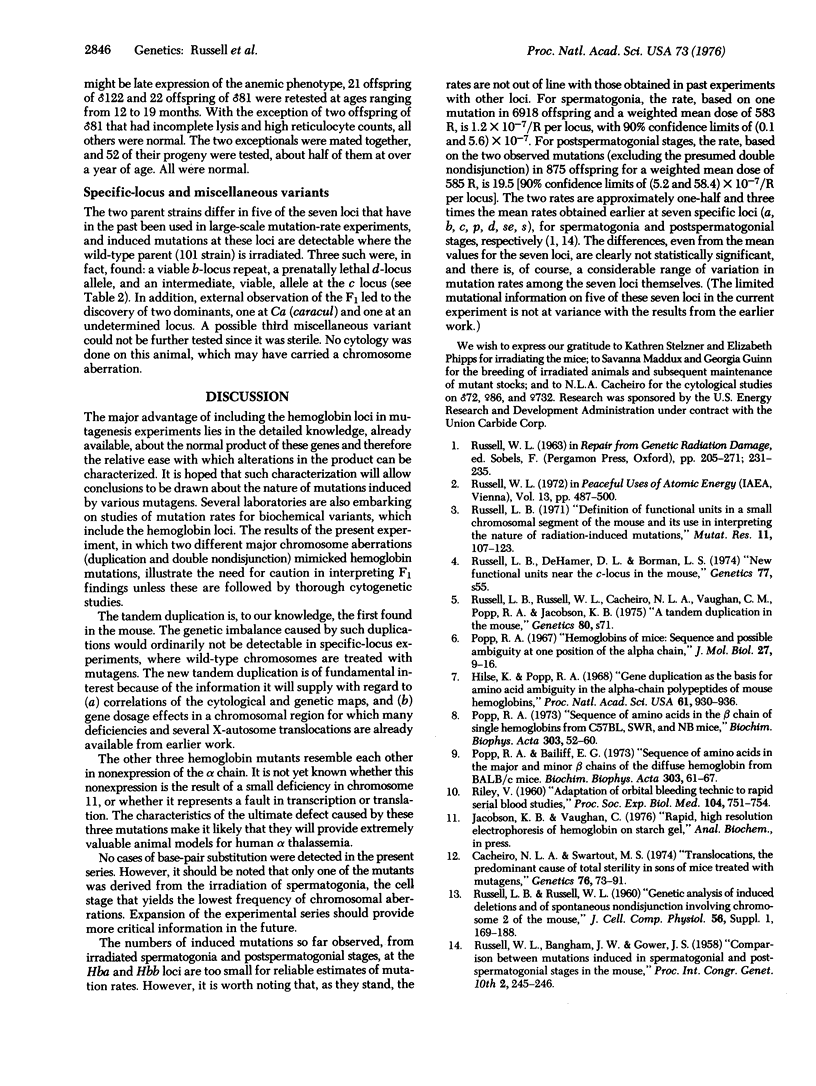Abstract
In experiments designed to detect new mutations affecting hemoglobin, we irradiated the male or female parent in reciprocal crosses of two mouse strains that differ in alleles at the hemoglobin (Hba, Hbb) loci as well as at five other specific loci. Offspring were analyzed for hemoglobin properties (electrophoretic pattern, solubility, crystal pattern), serum albumin differences, erythrocyte lysis, reticulocyte count, and external appearance. Five hemoglobin variants were found among the mutants. In three, the genetic contribution from the irradiated father was not expressed with regard to the alpha-chain; one carried a tandem deuplication (the first known case in the mouse) involving Hbb; and one probably resulted from double nondisjunction of chromosome 7. The finding that major chromosome aberrations can mimic hemoglobin mutations indicates the need, in similar experiments, to follow F1 screening with thorough cytogenetic analysis. The variants in which there is nonexpression of the alpha chain may be the result of small deficiencies or of faults in transcription or translation. Mutation rates based on these three variants are not out of line with earlier specific-locus results, although confidence limits are still wide.
Full text
PDF



Images in this article
Selected References
These references are in PubMed. This may not be the complete list of references from this article.
- Cacheiro N. L., Russell L. B., Swartout M. S. Translocations, the predominant cause of total sterility in sons of mice treated with mutagens. Genetics. 1974 Jan;76(1):73–91. doi: 10.1093/genetics/76.1.73. [DOI] [PMC free article] [PubMed] [Google Scholar]
- Hilse K., Popp R. A. Gene duplication as the basis for amino acid ambiguity in the alpha-chain polypeptides of mouse hemoglobins. Proc Natl Acad Sci U S A. 1968 Nov;61(3):930–936. doi: 10.1073/pnas.61.3.930. [DOI] [PMC free article] [PubMed] [Google Scholar]
- Popp R. A., Bailiff E. G. Sequence of amino acids in the major and minor chains of the diffuse hemoglobin from BALB-c mice. Biochim Biophys Acta. 1973 Mar 23;303(1):61–67. doi: 10.1016/0005-2795(73)90148-7. [DOI] [PubMed] [Google Scholar]
- Popp R. A. Hemoglobins of mice: sequence and possible ambiguity at one position of the alpha chain. J Mol Biol. 1967 Jul 14;27(1):9–16. doi: 10.1016/0022-2836(67)90347-6. [DOI] [PubMed] [Google Scholar]
- Popp R. A. Sequence of amino acids in the chain of single hemoglobins from C57BL, SWR, and NB mice. Biochim Biophys Acta. 1973 Mar 23;303(1):52–60. doi: 10.1016/0005-2795(73)90147-5. [DOI] [PubMed] [Google Scholar]
- RILEY V. Adaptation of orbital bleeding technic to rapid serial blood studies. Proc Soc Exp Biol Med. 1960 Aug-Sep;104:751–754. doi: 10.3181/00379727-104-25975. [DOI] [PubMed] [Google Scholar]
- RUSSELL L. B., RUSSELL W. L. Genetic analysis of induced deletions and of spontaneous nondisjunction involving chromosome 2 of the mouse. J Cell Comp Physiol. 1960 Nov;56(Suppl 1):169–188. doi: 10.1002/jcp.1030560415. [DOI] [PubMed] [Google Scholar]
- Russell L. B. Definition of functional units in a small chromosomal segment of the mouse and its use in interpreting the nature of radiation-induced mutations. Mutat Res. 1971 Jan;11(1):107–123. doi: 10.1016/0027-5107(71)90036-4. [DOI] [PubMed] [Google Scholar]



